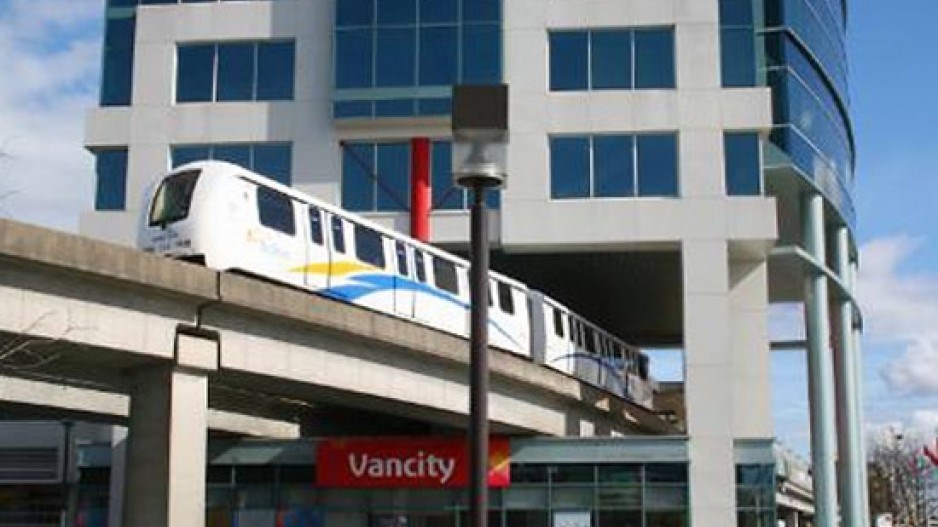Room for growth
“New investment is focused on nodes that will be serviced by future light rail transit,” reports CBRE Ltd. in its third-quarter review of investment markets across Canada.
But the comment isn’t about Vancouver; it’s about Waterloo, Ontario, where CBRE senior vice-president Peter Whatmore notes that the local market has experienced a rebalancing.
Cap rates average between 6.5% and 7.25% for office assets, offering “revenue sustainability” that entices investors to the region, Whatmore said in the report.
Among the active investors is Vancouver-based Concert Real Estate Corp., which recently added to its long-term investment portfolio with the purchase of the Sun Life Financial Inc. building on the south side of downtown.
Sun Life will lease back the property for a 20-year term, ensuring a stable flow of cash to Concert. But there is also long-term potential in the property, which sits along the rapid transit line that CBRE notes serves as a draw for investors. Moreover, there is ample potential to redevelop the property.
The office complex soars to 18 storeys, but is an agglomeration of multiple structures dating back to 1912.
A purchase price for the 15.9-acre Sun Life property wasn’t disclosed, nor was that of another major deal Concert announced recently: the acquisition from Vancouver’s Peterson Group of a half-interest in the 20.8-acre Langara Gardens site in South Vancouver.
In announcing the deal with Peterson, Concert emphasized the location of the property “within the evolving Cambie corridor.” Concert was an early contender for redevelopment of Oakridge Centre, but the Langara deal adds a mix of retail and residential space to its investment portfolio. The site is home to 605 apartments and townhomes, the earliest of which were developed in 1968.
Growth for rooms
While attending the recent Canadian Apartment Investment Conference in Toronto, Vancouver brokers David and Mark Goodman heard plenty about the need for new apartment construction. But they also heard about some of the new projects in the works to meet that need, not only in tight markets such as Vancouver but also in smaller centres where vacancies are several times the rates seen here.
Shortly after returning from Toronto, the Goodmans circulated a listing brochure for The Crest, a 121-suite purpose-built rental building at 775 Terminal Avenue North in Nanaimo priced at $21.5 million.
The duo has handled the sale of several new, purpose-built rental projects in the past couple of years; in one case, the $27 million sale of two rental apartment buildings at Intracorp’s MC2 project at Marine and Cambie prior to completion.
A common thread linking the Vancouver and Nanaimo projects is the high quality of their finishes and prime locations, something consultant Barry Lyons told the Toronto conference is helping new rental properties compete with condos as well as older rental buildings.
Nanaimo might not be a big city with rapid transit, but it is a growing city with a significant population of retirees, professionals and foreign students willing to pay for top-tier rental accommodation. In a market with a 5.3% vacancy rate, the Crest is full.
“There was a crying need for good rental accommodation on the island,” David Goodman said. “It’s a thriving community, there is some money there and they are prepared to pay a couple of hundred dollars more for good accommodation.”
But that doesn’t mean such projects are easy to do.
Developers hoping to replicate the Crest in the Lower Mainland face higher land costs and fees, and intense pressure on rental rates.
“In Vancouver, there are a number of projects that developers would like to build but the numbers don’t always materialize,” Goodman explained. “Even if you throw in the land for nothing, the numbers still don’t work.”
It’s difficult even in the suburbs, where land costs are cheaper but rents are also lower.
“You have to achieve strong rents,” he said, noting that this occurred in Nanaimo thanks to the particular circumstances of the property and the local market.
Growing gap
With civic elections just a few weeks away, municipal leaders took heat last week for their management of taxes on individuals and particularly businesses.
Vancouver’s Fraser Institute flagged West Vancouver for the greatest per-capita increase in spending among Metro Vancouver municipalities between 2002 and 2012, while issuing an editorial regarding Vancouver’s allegedly profligate ways versus the more responsible manner of Surrey. (See “A tale of two city spending policies”).
A particular area of concern is non-residential property tax revenue, which generates 45% of revenues for Vancouver and just 31% for Surrey.
The strain was picked up by the Canadian Federation of Independent Business, which flagged Coquitlam as charging businesses 4.5 times the tax rate residential property owners faced in 2013 – the worst in the Lower Mainland.
Vancouver, which has taken steps to redress the balance between business and residential property tax rates, charged businesses 4.33 times the residential rate in 2013. •




